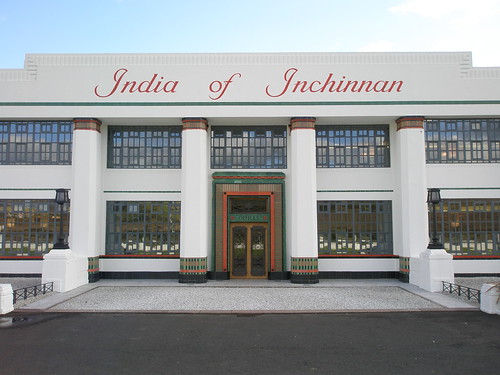In the second of two exclusive online extracts from the indispensable guide to the hidden joys of Scotland, Nothing to See Here, we look at a striking example of industrial art deco, which, thankfully, is looking as good as it’s ever done. You can buy Anne’s book here (it’s published by the intrepid folks at Pocket Mountains, which you should visit for some more inspired travel books).
The stark beauty of the India of Inchinnan building is an unexpected delight on the otherwise featureless A8 Edinburgh-Greenock road. One of Scotland’s finest remaining art deco buildings, it is a glorious sight – a two-storey white stuccoed exterior with simple red-, green- and black-tiled decorations, the name of its owners proudly spelt out above the entrance.
In 1930, when the building opened, business was booming for the India Tyre and Rubber Company. What better way to advertise their prosperity than a flagship office built in the contemporary art deco style. Leading modern architect Thomas Wallis was commissioned to design it as his practice, Wallis, Gilbert and Partners was known for its
elegant modern buildings. India of Inchinnan opened in between two of its other art deco masterpieces – the Firestone Building in Middlesex and the Hoover Building in Perivale.
This large expanse of flat, isolated land was an ideal spot for an company that wanted lots of space and a local workforce. In 1916 William Beardmore’s opened the Inchinnan Airship Constructional Station here. They built houses for their workers a safe distance away (in case of explosion) and for a while business was hugely successful, peaking in 1919 when their R34 airship made the first return transatlantic air crossing. When airship production waned after the war so did Beardmore’s fortunes and the site closed in 1922.
When India Tyres moved in in 1927 they reused the hangars for their production lines and built houses nearby to accommodate another few thousand workers. For over 50 years it was a successful business, but by the 1980s times had changed. In 1981 the office closed and the building became derelict – India of Inchinnan’s future looked bleak. There were various regeneration attempts but none took off until software firm Graham Technology (now Sword Ciboodle) stepped in.
Architect Gordon Gibb, a local man who had admired the building since he was a child, won the commission to bring the building back to life and the long restoration process began.
By 2003 the A-listed Art Deco block had been renovated and extended in a way that glorifies its past and sets it up for a new future. The main block has scrubbed up beautifully and behind it, a modern extension (as modern as the original building in its heyday) pays homage to Beardmore’s and the airships that were made here. Inside, the ceiling is a full scale replica of the underside of an airship and the wall lights spell out R34 in Morse code. The redevelopment won ‘Best Re-Use of an Historic Building’ at the Scottish Design Awards and is now Scotland’s only A-listed commercial building. It remains in use as offices and the R34 Restaurant which is open to the public.
http://www.indiaofinchinnan.
[Ed., you can find more photos here.]











wow what a building!
…and made all the more striking by being brilliant white rather than the usual slime-covered dirty grey green that most white buildings become on the west coast of this wet and windy island!
Splendid and how has the Poirot art director missed that one. The only Scottish building not, at one time, occupied by Mary Queen of Scots (it is said that she had spent two nights in our garage and four weeks in various Jedburgh council houses)
Wonderful building, both in it’s heyday (from pictures, word of mouth) and today. Extension a true compliment to local industrial and social history. Had my wedding reception in that building, will always be special!